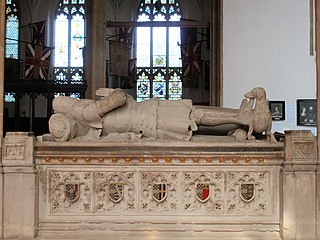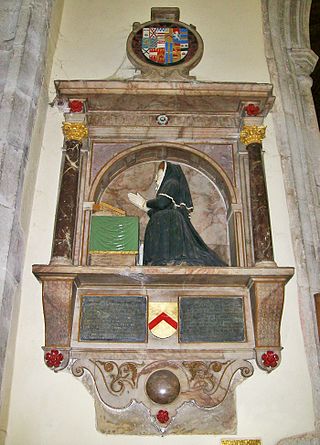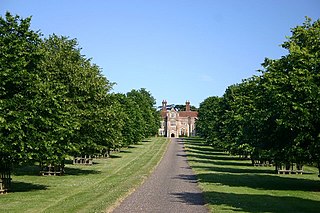
Hadleigh is an ancient market town and civil parish in the Babergh district of Suffolk, England. The town is situated next to the River Brett, between the larger towns of Sudbury and Ipswich. It had a population of 8,253 at the 2011 census. The headquarters of Babergh District Council were located in the town until 2017.

Sir Robert Drury (1456–1536) was an English knight, Lord of the Manor of Hawstead, Suffolk, and Knight of the Body to Kings Henry VII and Henry VIII. As a politician he was Knight of the Shire for Suffolk, Speaker of the House of Commons, and Privy Councillor. He was also a barrister-at-law. His London townhouse was on the site of today's Drury Lane.

Alpheton is a village and civil parish in the Babergh district of Suffolk, England. Located on the A134 road about six miles north of Sudbury, in 2005 it had a population of 260, reducing to 256 at the 2011 Census. According to Eilert Ekwall the meaning of the village name is the homestead of Aelfled.

Shimpling is a village and civil parish in south Suffolk, England. About 7 miles (11 km) from Bury St Edmunds, it is part of Babergh district. The village is formed from two halves, the newer Shimpling Street and about 2 miles (3 km) away the old village of Shimpling. The village has a Church of England parish church, where supermodel Claudia Schiffer and film producer Matthew Vaughn were married on 25 May 2002.

Lawshall is a village and civil parish in Suffolk, England. Located around a mile off the A134 between Bury St Edmunds and Sudbury, it is part of Babergh district. The parish has nine settlements comprising the three main settlements of The Street, Lambs Lane and Bury Road along with the six small hamlets of Audley End, Hanningfield Green, Harrow Green, Hart's Green, Hibb's Green and Lawshall Green.

Elizabeth Stafford, also known as Dame Elizabeth Drury and – in the years prior to her death in 1599 – Dame (Lady) Elizabeth Scott, was a Lady of the Bedchamber to Queen Elizabeth I. She and her first husband, Sir William Drury, entertained Queen Elizabeth I at Hawstead in 1578.

Hardwick House was a manor house near Bury St Edmunds, Suffolk, owned by Sir Robert Drury, Speaker of the House of Commons, of Hawstead Place. It was subsequently purchased in the seventeenth century by Royalist Thomas Cullum, a former Sheriff of London. Experts in Suffolk county history as well as noted authorities in antiquarian and botanical matters, the Cullum family of eight successive baronets authored works on the county and its fauna and flora. Sir Thomas Gery Cullum, a Charterhouse graduate, medical doctor and member of the Royal Academy and the Linnean Society, was a well-regarded author on science and botany.

Stanningfield is a village and former civil parish, now in the parish of Bradfield Combust with Stanningfield, in the West Suffolk district of the county of Suffolk, England. The village lies just off of the A134 road, about 5 miles (8 km) south-east of Bury St Edmunds, 5 miles/8 km north-west of Lavenham, and 10 miles/16 km north of Sudbury. In 1961 the parish had a population of 211.

Coldham Hall is a Grade I listed building, built in 1574, that is located in the parish of Bradfield Combust with Stanningfield in Suffolk. The Hall is very close to the village of Lawshall, and part of the Coldham estate is located within this parish.

The Parish Church of All Saints' Lawshall, is an Anglican church in the village of Lawshall, Suffolk, England. It has been designated by English Heritage as a Grade I listed building. The church is located in between Lawshall Hall and All Saints CEVCP Primary School. The church is in the process of joining the Chadbrooke benefice, whose Rector is Revd Matthew Lawson.

Lawshall Green is a hamlet in the civil parish of Lawshall in the Babergh district in the county of Suffolk, England. It is located east of Hibb's Green and is less than half a mile off the A134 between Bury St Edmunds and Sudbury.

Hanningfield Green, sometimes referred to as Hanningfields Green, is a hamlet in the civil parish of Lawshall in the Babergh district in the county of Suffolk, England. It is located between The Street and Hibb's Green and is just under a mile off the A134 between Bury St Edmunds and Sudbury.

Hibb's Green is a hamlet in the civil parish of Lawshall in the Babergh district in the county of Suffolk, England. It is located between Hanningfield Green and Lawshall Green and is just under a mile off the A134 between Bury St Edmunds and Sudbury.

Hart's Green is a hamlet in the civil parish of Lawshall in the Babergh District in the county of Suffolk, England. It is located between Stanningfield and Hanningfield Green and is just over a mile off the A134 between Bury St Edmunds and Sudbury. The road that serves Hart's Green is known as Donkey Lane.

Bury Road, Lawshall is a linear settlement in the civil parish of Lawshall in the Babergh district in the county of Suffolk, England. The northern part of the settlement is in the civil parish of Bradfield Combust with Stanningfield in West Suffolk. Bury Road is located between Hawstead and Lambs Lane / The Glebe and is two miles off the A134 between Bury St Edmunds and Sudbury.

The Street is a linear settlement in the civil parish of Lawshall in the Babergh district in the county of Suffolk, England. It extends from Lawshall Hall in the west to Donkey Lane in the east. The settlement includes Swanfield, east of the Swan Public House and the small residential development of Hall Mead which is opposite All Saints Church.

Lambs Lane is a nuclear settlement in the civil parish of Lawshall in the Babergh district in the county of Suffolk, England. In addition to Lambs Lane, the settlement includes The Glebe, Shepherds Drive, Windsor Drive, Churchill Close and Rectory Corner. Melford Road is partly within Lambs Lane and Golden Lane is to the west of the settlement.

The Church of Our Lady Immaculate and St Joseph, otherwise known as Coldham Cottage is the oldest continuing Roman Catholic church in Suffolk. It is in Bury Road, Lawshall and is part of the Diocese of East Anglia. It is in the Catholic parish of Bury St Edmunds. In 1998, it was designated as a Grade II Listed Building.

Sir William Drury was an English landowner and member of parliament. He was the father of Sir Robert Drury, patron of the poet John Donne.
Sir William Drury was the son and heir of Sir Robert Drury, Speaker of the House of Commons. He was a Member of Parliament and a Privy Councillor. His name appears in the Ellesmere manuscript of Chaucer's Canterbury Tales.



















